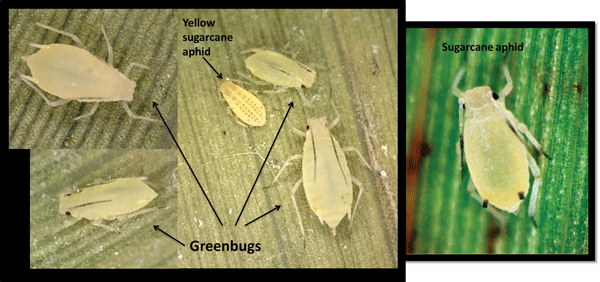By Brian McCornack, Sarah Zukoff, Jeff Whitworth and J.P. Michaud, Extension Entomologists
Sugarcane aphid infestations were confirmed on commercial grain sorghum fields near the Sumner/Cowley County border during the week of July 18-22.
Based on the size of the aphid populations observed, which included several plants that were producing winged aphids, this field was first infested approximately 3-4 weeks ago. A significant number of natural enemies were observed feeding on aphids, which can help slow aphid growth.
This is approximately 10 days sooner than when we found aphids in 2015. Aphid densities are well below threshold, but sorghum producers are encouraged to start scouting fields now.
Report all new infestations by contacting your county extension agent. For myFields.info users, submit reports using the Pest Sampler module (https://www.myfields.info/pest_sampler). To receive pest alerts about sugarcane aphid, create an account (https://www.myfields.info/user/register) and include your state and county information to receive notifications specific to your area.

Figure 3. Yellow sugarcane aphid, greenbugs, and sugarcane aphid.
When scouting, make sure you correctly identify the sugarcane aphid. It can be confused with greenbugs or yellow sugarcane aphid. The sugarcane aphid is light yellow, with dark, paired “tailpipes” called cornicles and dark “feet” called tarsi. Greenbugs have dark feet, dark antennae, but light colored cornicles (tail pipes).
Greenbugs will often have a green stripe down their backs, but this can be hard to see in light-colored aphids. The sugarcane aphid also has dark feet and darker antennae, however it has dark cornicles and no green stripe down its back. The yellow sugarcane aphid (Fig. 3) is bright yellow with many hairs on its body and no extended cornicles.
Two insecticides, Sivanto 200 SL, and Transform WD, provide superior control of sugarcane aphid. Sivanto can be applied at 4-7 fluid ounces per acre. Transform WG can be applied at 0.75-1.5 oz. per acre. It is important to achieve complete coverage of the crop in order to obtain the most effective control.
Sivanto and Transform are not toxic to beneficial insects, which can help control populations of the sugarcane aphid.
One of the problems some producers in Kansas faced last year was what to do if both headworms (also known as corn earworm) and sugarcane aphids were present at treatment thresholds. Sivanto and Transform are not effective on headworms.
The pyrethroid insecticides most commonly used for headworm control, methomyl and chlorpyrifos, are effective against the sugarcane aphid, but will also kill beneficial insects.
It was not uncommon last year to see sugarcane aphid populations explode a few days after the application of a pyrethroid insecticide. Flubendiamide (Belt), chlorantraniliprole (Prevathon), and spinosad (Blackhawk) are non-pyrethroid insecticides which are effective on headworms, but have low impact on beneficial insects.
If headworms are present in damaging numbers, the best advice is to spray an insecticide anyway since headworms can quickly cause significant yield losses if populations are high enough. Fields should be scouted for sugarcane aphids and beneficial insect populations often after the insecticide is applied.
If sorghum has to be treated more than once or twice with an insecticide, producers may hesitate since the cost can add up quickly. However, sugarcane aphid and headworms can cause significant yield losses, which can make the field even less profitable than if multiple insecticide applications were made to help protect yields. It’s not an easy choice to make, by any means.
For more information on sampling procedures, action thresholds, or effective insecticides, visit https://www.myfields.info/sca/






Post a comment
Report Abusive Comment